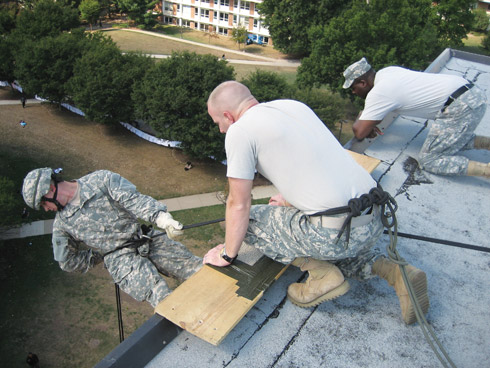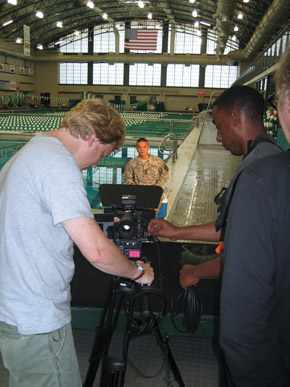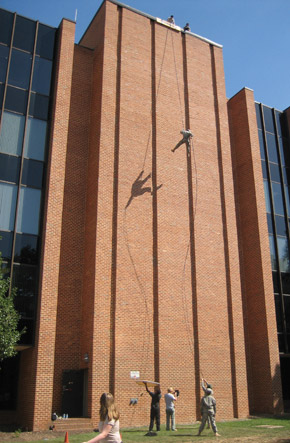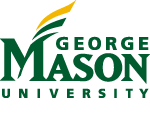
Dan Morgan, a senior majoring in sociology, prepares to rappel down the side of the five-story Fenwick Library as part of an ROTC training exercise.
Defense Mechanism
Mason’s on-the-rise ROTC program is giving students way more than basic training to be future leaders in the military—and the world
By Dave Andrews
It’s not all about rappelling down tall buildings, shooting paintball guns in the woods, or practicing water combat techniques. But it sure does sound like an exciting way to train.
That’s how Mason’s Army Reserve Officer’s Training Corps (ROTC) program operates. It puts young men and women in a variety of situations, which are often fun, to build confidence and learn leadership.
By teaching these essential skills to its cadets, the ROTC has steadily grown in popularity at Mason. Since 2000, when Mason’s ROTC transitioned from a subordinate company of Georgetown University to a separate battalion, 101 cadets have graduated from the program as commissioned officers. But this year alone, Mason has 127 cadets working toward that goal.
“Our program here at Mason is experiencing tremendous growth,” says Lt. Col. James Overbye, professor of military science. “This can definitely be attributed to the university’s supportiveness and a history of high-caliber cadets who have gone on to do great things.”

Randy Mendoza, above, a senior majoring in economics, is interviewed for an ROTC recruiting campaign after a demonstration of a combat water survival training exercise at Mason’s Aquatic and Fitness Center.
Mason is one of some 270 colleges and universities around the country to offer Army ROTC courses. Whether taken as a four-year program or just a few classes, ROTC is an elective available to any student regardless of major.
Most cadets begin with the Basic Course, which is usually taken over two academic years and includes classroom courses such as military history, leadership development, and national defense. After completing the Basic Course, students can enroll in classes in tactics, ethics, and professionalism. Cadets spend a summer enrolled in the Leadership Development and Assessment Course between their junior and senior years.
“The overall goal is to develop the leadership and confidence necessary to succeed, whether in the military or some other capacity,” Overbye says. “These types of courses, in addition to the physical training, have been shown to do just that.”
Beyond the excitement of rappelling and shooting paint balls, the obvious benefit that catches the eyes of many potential cadets is the financial assistance. The ROTC offers two-, three- and four-year full-tuition scholarships to hundreds of students each year. It also offers money for books and a monthly allowance to help cover other college expenses.
“I originally enlisted just to pay for school. The financial benefits are great,” says John Morgan, BA Global Affairs ’07, a battalion commander in Mason’s ROTC. “But I immediately fell in love with the culture and training aspect. I also came to learn that it’s a great way to network and learn how to work well with others.”

Twice a year, ROTC cadets rappel down buildings on the Fairfax Campus as part of their training.
Morgan, who graduated in December, has aspirations to soon be overseas, working in any of a number of multilateral programs such as NATO.
For others, working in the military has been a lifelong goal.
“I knew from a young age that I wanted to be a military officer,” says Lt. Graham Shelley, BA Government and International Politics ’07. “But having the freedom to choose from a wide variety of majors and postcollege opportunities is what really attracted me [to the ROTC].”
Shelley says he came all the way from New Mexico to Mason because it offered him the major he was looking for, and the cost-benefit ratio at Mason was right for him.
Once cadets successfully complete the ROTC program and other academic requirements, they are commissioned as second lieutenants and begin military service. They have the choice of serving full time on active duty or part time in the Army Reserve or National Guard for three to four years.
Shelley was selected to remain at Mason as an ROTC gold bar recruiter until he receives his next assignment. “The program is terrific because it provides you with ample time after college to determine what career move to make,” he says.

